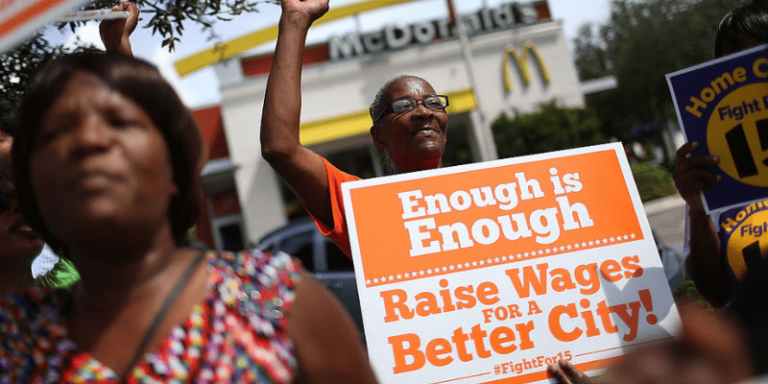What’s Up with the Minimum Wage?
How much should people get paid for their work?
By: Andrew Moran | August 1, 2019 | 420 Words

(Photo by Joe Raedle/Getty Images)
Since July 2009, the federal minimum wage has been $7.25 per hour. The House of Representatives voted to raise it to $15 by 2025, but the Senate probably won’t. But why is the minimum wage such an issue between Republicans and Democrats in Washington? Let’s explore the pros and cons of this public policy.
Pros of Minimum Wage
People think higher pay will lead to higher spending. This would raise demand, create more jobs, and generate greater business revenues. When employees get a bigger paycheck, tax revenues go up. With more tax money, public officials can spend more on education, infrastructure, health care, and other public services. Advocates also think a mandated wage floor is better than expanding the welfare state or instituting a universal basic income because it encourages people to get and keep jobs.
Cons of Minimum Wage
Young people usually lack the skills, work experience, and education to satisfy the requirements of a position. Because of this, a young person will not create $7.25, $10.10, or $15 in value to a company for every hour he or she will work. Instead, he or she might only be worth $5 per hour. Companies might not be willing to pay the higher rate. This leaves young people stuck without jobs.
As the minimum wage goes up, some people earn less take-home pay. These workers experience a decline in their annual earnings. On one hand, they will make more per hour, but their earning power drops due to fewer hours, less compensation and, if they get them, a drop in tips.
Research has found that higher minimum pay causes a business to not hire new workers. If this is the case, then younger workers cannot improve their human capital – the abilities and experience determined as value for an organization. In the last couple of years, fast-food franchises have added kiosks, supermarkets have self-serve checkouts, and even some restaurants have robotic chefs.
 Economic Effects
Economic Effects
While surveys suggest that most Americans support a $15 an hour minimum wage, free-market supporters say that this is bad for workers. Some libertarians have referred to it as “compulsory unemployment,” and some conservatives have called it an anti-worker policy. But left-leaning academics say it is necessary to reduce income inequality and prevent the private sector from hosing employees.
The economic reality is that unskilled workers, mostly youth, compete against other workers to win better incomes and trying to combat the rise of labor-saving technologies. The verdict is still out if the $15 minimum wage has been a good or bad idea.
















